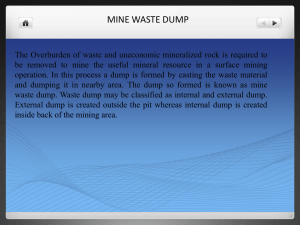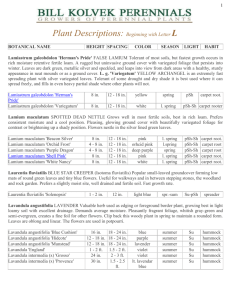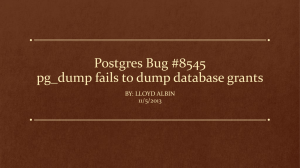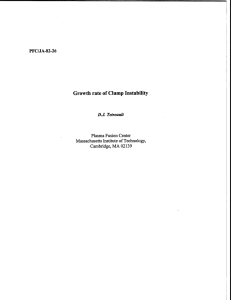Let`s Talk About Vocabulary Strategies presentation
advertisement
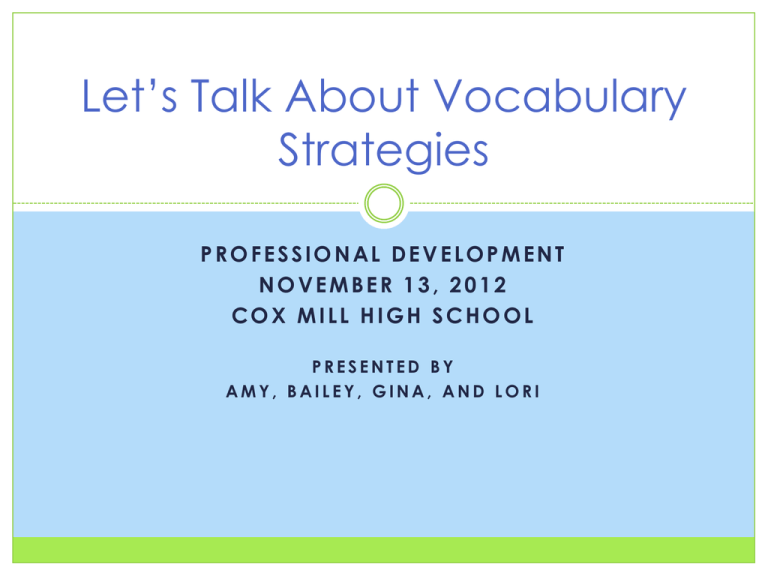
Let’s Talk About Vocabulary Strategies PROFESSIONAL DEVELOPMENT NOVEMBER 13, 2012 COX MILL HIGH SCHOOL PRESENTED BY AMY, BAILEY, GINA, AND LORI Guidelines for Selecting Vocabulary Do… Less is more -- depth is more. Teach fewer vocabulary terms, but teach them in a manner that results in deep understandings of each term. Teach terms that are central to the unit or theme of study. These are terms that are so important that if the student does not understand them, s/he likely will have difficulty understanding the remainder of the unit. Teach terms that address key concepts or ideas. While a text chapter may contain 15-20 vocabulary terms, there may be only 4 or 5 that address critical concepts in the chapter - sometimes only 1 or 2!). Teach terms that will be used repeatedly throughout the semester. These are foundational concepts upon which a great deal of information will be built on over a long-term basis. Guidelines for Selecting Vocabulary Avoid… Teaching or assigning words from textbooks just because they are highlighted in some way (italicized, bold face print, etc.). Teaching or assigning words just because they appear in a list at the end of a text chapter. Teaching or assigning words that will have little utility once the student has passed the test. Assigning words the teacher cannot define. Assigning large quantities of words or words that students will rarely encounter again. Dump and Clump Purpose: This strategy is used to provide a deeper understanding of vocabulary/content information by using critical thinking skills to categorize words. Description: Students begin by organizing their words and placing them into the appropriate categories. The conversation that goes on each group will help in understanding and retention of the words. Dump and Clump The teacher may provide the categories or the students can create their own categories depending on the content and level of the students. The teacher may also choose to have each group write a summary sentence using words from the categories. Dump and Clump Procedure: 1. Group students into small groups of 2-3. 2. “Dump” – Have students develop a list of words, items, or new information related to the topic of study. 3. “Clump” – Using the “dump” word list, students should categorize (clump) and label words from the list. Dump and Clump 4. Have students write a descriptive summary sentence for each category of words. 5. Upon completion, these should be posted around the room or shared in small groups. Rogers, S., Ludington, J., & Graham, S. (1999). Motivation and learning. Evergreen, CO: Peak Learning Systems. Dump and Clump Directions: Brainstorm words related to the anatomy of the Brain, Heart, Skin, Tooth, Ear, and Eye. Place these words in the “Dump”ster. Then, pull your words out of the dumpster and clump them into categories. Finally, assign your category labels and write a summary sentence (on the back) describing each category. Dump and Clump The Dumpster Dump and Clump cerebrum aorta pupil cochlea dentin retina root artery enamel subcutis frontal lobe cerebellum Brain Anatomy cerebrum cerebellum frontal lobe Tooth Anatomy root enamel dentin epidermis ventricle dermis anvil hammer optic nerve Heart Anatomy aorta artery ventricle Ear Anatomy anvil hammer cochlea Skin Anatomy dermis epidermis subcutis Eye Anatomy retina pupil optic nerve Are you ready to move? Kick Me! There is ABSOLUTELY NO KICKING! The teacher will place a sticker on your back. When the timer starts, get out of your seat and take your chart with you. Your job is to find the missing words to the analogies on your sheet. When the timer buzzes, return to your seat. If you finish before, return to your seat and sit on your desk. Kick Me! Can be used for anything! Preteaching tool when students don’t really know the answers. As a review activity so that they already know the answers but have to find the exact words. For figurative language where the kids have the definition of hyperbole or simile, metaphor and they have to find the examples. It also works for definitions. Give them the definition and they must find the words. You could also have them match vocabulary words with antonyms, synonyms, pictures, or definitions. Kick Me! Why Use It? It allows students to get up and move. The more they move, the more they are engaged. Brain research supports having the blood moving to the brain will help with retention and focus. They can talk and interact with each other. It’s FUN! https://www.teachingchannel.org/videos/making-vocabulary-lesson-interactive Word Splash Word Splash- a collection of key words or concepts chosen from a passage that students are about to read. Word Splash helps to: -activate prior knowledge -set a clear purpose for reading -decipher vocabulary -provide motivation for reading -allow for a variety of modes of learning Word Splash Teacher prep: -From a passage that students will be reading, select key terms or concepts. -Put the topic or main idea in the center of a page, and surround with the selected key terms. Before reading: - Students will predict how the terms relate to the main idea of the reading. They will create sentences predicting the relationship between the main idea and key words. During reading: -Students will check the accuracy of their sentences. After reading: -Students will revise predictions based on the text. Word Splash Possible variations● ● ● Have students work in small groups and each group would share their ideas with the whole class. Students look for common elements and list them. Then they would read the text, and discuss the similarities and differences as well as the reasons for the differences. Have students skim a text, selecting 7-10 words or phrases. They would then prepare a word splash for another group to use before reading the text. Choose words that may seem contradictory to the others. Reading Passage – Civil War For four years between 1861 and 1865 the United States engaged in a civil war. Divisions between the free North and the slaveholding South erupted into a full-scale conflict after the election of Abraham Lincoln as president in 1860. Eleven southern states seceded from the Union, collectively turning their back on the idea of a single American nation. Lincoln, who had been in office for only six weeks, declared these acts of secession illegal, and asked Congress for 500,000 soldiers to crush what threatened to be an aggressive rebellion. In April 1861, the first shots were fired and what followed became a national tragedy of unimaginable proportions. More than 600,000 soldiers were killed and millions more wounded; large sections of the South were ravaged by violent battles; and the Union nearly collapsed under determined Confederate forces. http://www.shmoop.com/civil-war/summary.html Wordle 3 x 3 Vocabulary Purpose: To promote the development of complete sentences as well as the identification of relationships between concepts. Description: In this activity, students will take related words, ideas, and concepts and combine them together in sentences. The sentences should illustrate the relationship among the words, ideas, and concepts. This can be used as a form of alternative assessment as well as a cognitive teaching strategy. 3 x 3 Vocabulary Procedures: 1. Pass out a 3x3 Vocabulary sheet to each student. 2. The sheet can be filled out in one of two ways: - assign specific words to their blocks, - or allow students to choose from a word list, placing words in the blocks they choose. 3. Once the sheet is filled out, students should write six sentences which illustrate the relationships between the words in column 1 down, 2 down, 3 down, and rows 1 across, 2 across, and 3 across. 3 x 3 Vocabulary Example: Filter Database Field Data Sort Row Report Descending Ascending Column 1 Down: After filtering my data for all countries located in the Nordan region, I ran a report of their major imports and exports. Column 2 Down: I sorted my database in descending order so that I could look at my records in alphabetical order. Column 3 Down: While my database contains both fields and rows, the only way I can sort in ascending order is by field. Column 1 Across: Using the filter tool in my database application, I can isolate data in particular fields. Column 2 Across: When I sort my data, I do so by fields, not by rows. Column 3 Across: When running a data report, I can choose to have my data in either descending or ascending order. 3 x 3 Vocabulary Variation: Spence Rogers uses a variation of the 3x3 Vocabulary activity. In his activity, Mix and Match, related word, ideas, and concepts are written on individual index cards. All cards are put into a basket. In round robin fashion, cards are drawn two at a time. The student then must generate a sentence using those two words which describes their relationship to each other. Vocabulary Sorts Purpose: Vocabulary sorts are used to match vocabulary words with a definition and a picture representation or example. Procedures: 1. The students are given a baggie of cutouts that have vocabulary words, definitions, and picture/examples cards in them. 2. Students must put the cards into the appropriate column and match them correctly. 3. The cards can either be placed back in the baggies for reuse, or the students could glue the cards onto a chart to keep as a study resource. Vocabulary Sort Procedures: 1. The students are given a baggie of cutouts that have vocabulary words, definitions, and picture/examples cards in them. 2. Students must put the cards into the appropriate column and match them correctly. 3. The cards can either be placed back in the baggies for reuse, or the students could glue the cards onto a chart to keep as a study resource. Vocabulary Sort Variation: Another idea is to pass out one card to each student. Then have the students find their partners to form the correct groups of three (term, definition , example). Thank you! Thank you for coming tonight. Please check out the Livebinder for more resources. * Link on the handout.

